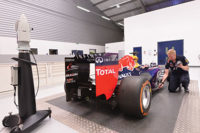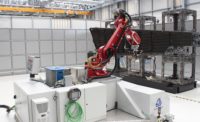There are major technology disruptions afoot in the world of conventional portable metrology. For the better part a decade, 6DoF laser tracking has been the standard go-to technology for metrologists in the large-scale manufacturing sectors. As OEMs and mid-level suppliers shift their sights toward the Factory of the Future, the need for manufacturing intelligence and automation tools has intensified. A new breakthrough called 7DoF—7 degrees of freedom—has cracked the code on what is deemed to be the next frontier in laser tracking.
6DoF Beginnings
In technology development, foundational details truly matter. The plan to create a 6 degrees of freedom (6DoF) laser tracking technology was set in motion in the late ‘90s. The project was initiated by a customer request for a handheld scanner that could scan an object the size of a car or larger with an accuracy level far better than photogrammetric systems could provide at the time. The development of all of our 6DoF systems came from the requirements to build the first handheld scanner designed to work in tandem with laser tracking systems. I will explain the significance later.
However, the first tracker-ready product we designed and produced was a handheld, wireless probe used to acquire hard-to-reach points. The main objective was to put a tool in a laser tracker operator’s hand that would make the user experience more comfortable when trying to acquire 3D point data on part surfaces. With an eye on the big picture, the overall platform had to be dynamic and high speed. The user would accurately measure with 6 degrees of freedom in three dimensional space—x,y,z and i, j, k—in both a static and dynamic state as well.
Dynamic vs. Static Accuracy
When a user is probing a part, the need for dynamic accuracy is not very high. Static measuring is simply putting a probe on a point, pressing a button and getting a result. If an operator is measuring a hole or a surface or an edge line, this approach is perfectly acceptable to get a good result. On the other hand, when a user is scanning, performing machine control or conducting non-machine regimen, dynamic accuracy becomes absolutely paramount as the operator is now measuring an object while in motion, such as holding a laser line scanner and waving it over a car or an aircraft wing.
The only difference between the two approaches is a static point measurement is measured to the center of the probe tip (a ruby stylus) at a fixed point. A user can perform dynamic probing, such as dragging a ruby tip across a surface to acquire points. This technique is seldom used because our hand scanner collects 210,000 points per second as opposed to a mere 1,000 points per second using the handheld probe, over the same part and surface.
History makes a difference in this case. The R&D team did not view this project as just building a probing system or adding a probe to the newest generation of laser trackers. The core vision came from a larger scope of adding dynamic 6DoF capability to the tracker right from the start. The original design intent was threefold: 1) to build a handheld scanner, 2) to mount the hand scanner on a robot for automated scanning, and ultimately 3) perform automated machine control with a tracker-machine control sensor.
In order to check off these capabilities from the wish list, the system needed to generate dynamic tracking measurements capabilities and push that information out of the laser tracker with a minimal latency between when the points are actually measured and when they are communicated back to the controller of a robot or a CNC machine. These are the foundational elements for breaking ground into the new 7DoF frontier of laser tracking.
7DoF Rewrites the Rules
Essentially, 7DoF combines all of the technology behind 6 degrees of freedom measurement and gets it processed and communicated out of the tracker as quickly as possible. This newest generation laser tracker has the ability to pass a measurement into a control loop to be utilized for an application with an uncertainty of a few microseconds.
When delving into a 7DoF world, conventional wisdom about metrology and metrology software changes, because Microsoft Windows is not a real-time operating system. When running a real time control loop, the application has to run in a real-time control system, which could be as common as Linux, or as unique as VXWorks, or even a PLC (programmable logic controller).
There are a number of ways data can be fed into those systems. One method is called free running data which is 1,000 6DoF measurements per second flowing into a control loop as fast as you can feed it. Another data feed method is zero sync trigger where data is flowing in, but the entire control loop has a synchronized pulse as well. This means that every measurement has the same stamp as everything else in the control loop.
For example, if the control loop is running at a 1,000 Hz using the 1,000 Hz clock, every measurement, one thousand times a second, is being synchronized at the same point. So when a robot is moving and a laser tracker is measuring those movements, both the robot signals and the tracker signals have a trigger sync that happens at exactly the same point. Even if there is a small jitter between the two, it can be recovered in the control loop.
Difference between Synchronization and Real-Time
The processing of this data is different using a Windows-based operating system and metrology software where the same 1,000 measurements per second is fed into the software with a timestamp. The time stamp is still accurate to the 5 microsecond uncertainty the system affords, which is fundamentally the difference between synchronization and real-time.
For instance, a robot is performing a grinding task with a tracker-machine control sensor attached. This 6DoF tracking device measures the robot through all of its movements. The software can tell the robot to start now, and also command the tracker to start at the same trigger. The resulting data can be reviewed in an offline software suite and processed to analyze the location of the robot using the tracker output, and where the robot “thought” it was spatially. The software can immediately identify any uncertainty or differences between the two. The process can be accomplished without real-time, because it just synchronizes the two systems.
However, if a production process required the same data to correct the robotic path, then a real-time control loop is required. In the first circumstance, the data is verified to establish where the robotic positions are, and where they should be. In the second circumstance, the robot is being positioned with laser tracker data where the low latency communication back into the robot control loop is required.
Ready for the Factory of the Future
So why is 7DoF technology important? To start, there is a full-fledged movement in the manufacturing industry to bring quality control inline. This new era of closed loop manufacturing and on-demand intelligence is most complete when customers have real-time access to 3D measurement data. 7DoF provides the “big leap forward” features that have been missing until now to move enterprises in the direction of machine automation and the factory of the future.
Companies are now in the process of forging data-driven strategies leveraging quality data to gain new insights into production. Our dynamic approach to 6DoF technologies laid track for the 7DoF-enabled innovations being used now in the major development projects like MEGAROB and Kraken. The MEGAROB project developed a flexible, sustainable and automated platform for high accuracy manufacturing operations in medium and large complex components using a spherical robot, a laser tracker and an overhead crane. Kraken, a project in action, is aimed to develop the largest 3D printer and subtractive manufacturing system in the world.







